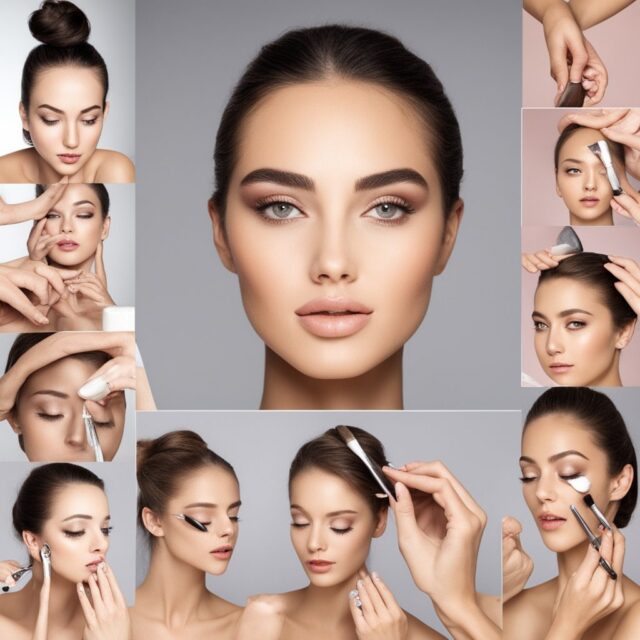Vertical Labret Piercing: Style Meets Self-Expression
For those who appreciate uniqueness, a vertical labret piercing is a more modern version of a ring through your lip! A vertical labret piercing is a distinctive form of body art that adorns the lower lip with a bold, vertical placement. Unlike a standard labret piercing—which penetrates horizontally through the lip into the mouth—this style avoids oral contact entirely. Instead, it’s pierced vertically through the centre of the lower lip, with the jewelery entering the top and exiting beneath the lip’s edge. This creates a sleek, symmetrical look, showcasing a curved barbell that hugs the lip’s natural contour.
It is ideal for anyone who likes to show a little edge while remaining flawlessly elegant; vertical labret piercings can weave beautifully with casual and dresser aesthetics. The process entails careful positioning so a trained professional can ensure no contact with teeth or gums, so healing is relatively simple with basic hygiene. Healing generally takes 6–8 weeks, with results that vary depending on aftercare diligence.
What Is a Vertical Labret Piercing?
Vertical labret – A unique piece of body jewelery that sits vertically above the bottom lip. Whereas with a standard labret piercing—the kind that pierces the lip horizontally and goes into the mouth—that’s not the case, this style keeps everything out of the mouth. Instead, it is punctured vertically through the centre of the lower lip, the jewelery entering the top and emerging beneath the lip’s edge. This gives rise to a sleek, symmetrical appearance, highlighting a rounded barbell that follows the lip’s natural contour.
- Vertical vs. Standard Labret: Key Differences
- The most significant difference between both is where you put them and how they feel in your mouth. The traditional labret piercing sits flush with the base of the bottom lip, leaving a stud inside the mouth, which could gradually corrode away gum or teeth over time. The vertical labret, however, skips the mouth entirely, reducing dental risks. Its jewelery—typically a curved or circular barbell—is visible on both ends, emphasizing its vertical orientation for a more dramatic aesthetic.
2. Inverse Vertical Labret vs. Traditional: Breaking Down Variations
- The reverse vertical labret uses this placement in reverse, while the classic vertical labret comes out underneath the bottom lip. This less common type enters from within the mouth (underneath the lower lip) and protrudes upward, emerging through the top of the lip. The result? Jewelery seems to “dangle” from the lip’s centre, presenting an unusual twist. However, this style may involve slight oral contact, so discussing placement with a skilled piercer is crucial to minimize complications.
Why Choose a Vertical Labret?
This outrageously versatile piercing balances visual interest and practicality, making it an excellent body mod for all things edgy yet not high-maintenance lovers. Good aftercare is required, such as saline rinses and refraining from oral contact for 6–12 weeks for healing. Whether you prefer subtlety with a tiny bead or drama with gemmed ends, the vertical labret adapts to your style.
Ready to explore this bold lip piercing? Consult a certified piercer to tailor placement, jewelery and care for a safe, stunning result.
How Is a Vertical Labret Piercing Done?
A vertical labret piercing combines artistry and precision. Here’s a step-by-step breakdown of the process:
- Consultation & Marking: A professional piercer evaluates your examines to ensure it is placed correctly on your place dot vertically below the centre, avoiding nerves and blood vessels vertically below racing. The piercer uses a sterilized needle to make a clean plunge at the dotted spot, pushing it vertically until it comes out below the lip’s edge.
- Jewelry Insertion: A curved barbell—designed explicitly for this piercing—is inserted. Its gentle arc follows the lip’s curve, minimizing movement and irritation during healing.
- Why Curved Barbells? Barbells—usually made of titanium or surgical steel—fit into the lip’s curve. The jewelery’s curve prevents pressure on the base of the piercing channel, facilitating a more rapid healing rate than straight jewelery.
Professional Expertise Matters
Choosing a reputable piercer is not up for discussion. They know where to place the piercings so as not to impede physical function, use sterile materials, and provide personalized aftercare instructions to prevent complications like migration or infection. DIY attempts or amateurs put people at risk of damaging nerves, scarring, or having uneven outcomes.
How Painful Is a Vertical Labret Piercing? What to Expect
The pain of a vertical labret piercing is described as a sharp pinch and quick pressure. Compared with the standard lip piercings (think labrets or snake bites), it’s less intense because it doesn’t go through the sensitive inner mouth or contact the gums. They give it a 4–6/10 on the pain scale.
Factors That Influence Pain
- Individual Pain Tolerance: Your baseline sensitivity plays a role—some feel mild discomfort, others a sharper sting.
- Lip Thickness: Thicker lips require piercing through more tissue, which can increase momentary pain.
- Piercer’s Skill: An experienced professional uses precise techniques to minimize trauma, reducing pain and swelling.
Healing Process & Recovery Discomfort
Initial soreness and swelling last 3–7 days, with complete healing taking 6–12 weeks. Discomfort during recovery is usually mild but manageable with saline rinses and avoiding lip movement (like kissing). Tender crusting or throbbing may occur, but severe pain could signal infection—consult your piercer if concerns arise.
How Much Does a Vertical Labret Piercing Cost?
Curious about the cost of a vertical labret piercing? Prices vary by location, studio reputation, and jewelery choice. Here’s what to expect:
- Average Cost by Region
A vertical labret piercing costs $50 to $100 in the USA and about £40 to £80 in the UK. Studio owners in major cities (New York or London) tend to charge more, owing to higher overheads. The range in Australia is between AUD 70 and 120; in Europe, prices vary from €50 to € 90, depending on the country.
- Factors That Influence Price
- Piercer Expertise: Seasoned professionals with certifications may charge more, but their precision reduces risks like uneven placement or infection.
- Jewelery Quality: Basic surgical steel curved barbells start at $20, but hypoallergenic titanium or gold options can add $30–$50. Always opt for body-safe materials to avoid irritation.
- Studio Standards: High-end studios with autoclave sterilization and private rooms often charge higher fees than walk-in shops.
- Additional Costs to Consider
- Aftercare Products: Saline spray or antiseptic solutions cost $10–$20 if not included.
- Jewelery Upgrades: Swapping your initial jewelery post-healing (6–12 weeks) might cost $15–$30, including fitting fees and the new piece.
- Unexpected Issues: Infections or migration could mean extra clinic visits, though rare with proper care.
Is It Worth the Investment?
There are cheap options, but investing in a good piercer and quality jewelery goes a long way to ensure that your piercing will be less painful and safe. Note: This piercing has been for years—scrimping now may result in pricier fix-ups later. Tip: Always inquire about a complete cost breakdown before finalizing your reservation!
So, budget $80–$150 (including jewelery and aftercare) for your new vertical labret piercing, which should be done carefully.
Healing & Aftercare Tips for a Vertical Labret Piercing
A vertical labret piercing generally heals for 6–12 weeks, although the initial tenderness will disappear within 1–2 weeks. Aftercare is very important after a wax, the exact reason being to prevent complications and ease recovery.
Essential Aftercare Practices
- Cleaning: Rinse gently 2–3 times daily with a sterile saline solution to remove debris. Avoid alcohol, hydrogen peroxide, or harsh soaps—they can dry the piercing and delay healing.
- Avoid Touching: Dirty hands introduce bacteria. Resist twisting the jewelery or playing with it.
- Skip Irritants: Do not smoke, eat spicy foods, or use alcohol-based mouthwash for the first week. Kissing or oral contact can be resumed after swelling (2–3 weeks).
What’s Normal vs. Infection Signs
Mild redness, swelling, and clear/white discharge are normal initially. However, persistent throbbing, yellow/green pus, excessive heat, or fever signal infection—consult a piercer or doctor immediately.
Additional Costs & Upkeep
Aftercare products such as saline spray ($10-15) and non-woven gauze ($5) also contribute to initial expenses. If you’re uncomfortable changing out jewelery after 6+ weeks, you might need to pay a professional switch fee ($10 to $20). Choose titanium or gold, ideally hypoallergenic, to avoid reactions.
Pro Tips for Success
- Sleep on your back to avoid pillow friction.
- Stay hydrated to moisturize lips (use unscented balm outside the piercing site).
Best Jewelry for a Vertical Labret Lip Piercing
Choosing the right jewelery for your vertical labret piercing is key to blending style with safe healing. Here’s how to pick wisely:
1. Curved Barbells Are Essential
Vertical labrets also use curved barbells to follow the shape of the natural lip. Straight jewelery can irritate or migrate in the skin. Wear a long barbell long enough to accommodate the initial swelling (10–12mm) and downsize to 8–10mm diameter when you are healed.
2. Prioritize Body-Safe Materials
- Titanium (implant-grade): Lightweight, hypoallergenic, and ideal for sensitive skin.
- Surgical Steel (316L): Durable and affordable, but avoid if nickel-sensitive.
- 14k/18k Gold: Luxurious and biocompatible—choose nickel-free options to prevent reactions.
Avoid acrylic or low-quality metals, which can trap bacteria and delay healing.
3. When & How to Change Jewelry
Wait 6–12 weeks until fully healed before swapping jewelry. For the first change:
- Wash hands and sterilize tools.
- Gently unscrew the ball ends in front of a mirror.
- Insert a pre-sterilized barbell. If uncomfortable, visit your piercer for assistance.
Aftercare Products for Success
- Clean daily with a sterile saline spray ($10–$15) to prevent infection.
- Avoid alcohol-based products or ointments that clog the piercing.
- Use a travel pillow to avoid snagging jewelery while sleeping.
Final Tip: Invest in quality jewelery and patience—rushing the process risks irritation or scarring. With the right curved barbell and care, your vertical labret will heal flawlessly, letting your bold style shine!
Vertical Labret Piercing Risks & Downsides
While a vertical labret piercing offers bold style, it’s not without risks. Understanding potential complications helps you decide if it’s right for you.
Common Complications
- Swelling: Severe swelling for 3–7 days is normal, but excessive inflammation may indicate irritation or infection.
- Migration/Rejection: The body may push the jewelery outward, causing scarring. This is more likely with improper placement or low-quality jewelery.
- Tooth/Gum Damage: Poorly fitted barbells can rub against teeth, leading to enamel wear over time.
Risk Factors for Scarring or Rejection
Thin lip tissue, aggressive aftercare (e.g., over-cleaning), or harsh products like alcohol-based mouthwash raise risks. Skipping hypoallergenic jewelery (titanium, 14k gold) also increases rejection chances.
Inverse Vertical Labret vs. Standard
An inverse vertical labret (attached horizontally through the lip’s centre) is more prone to rejection quicker because it’s not very deep and constantly moves. While standard vertical labrets are more stable, they can still migrate if they get snagged or bumped continuously.
Aftercare Products to Minimize Risks
Frequent use of saline spray 2x daily (1% to 10% is free salt) ($10–15). Do not use cotton swabs, which can leave fibres. Avoid ointments, which trap bacteria. For oral care, use alcohol-free mouthwash since it will dry up the mouth.
Although there are risks, a well-trained piercer and disciplined aftercare improve the odds. Observe for unusual pain or discharge and act promptly to prevent chronic damage!
Pros & Cons of a Vertical Labret Piercing
Pros:
- No Inside-Mouth Irritation: Unlike traditional lip piercings, the jewelery sits outside the mouth, reducing tongue or gum contact.
- Tooth/Gum-Friendly: Lower risk of enamel damage compared to oral piercings.
- Stylish Edge: Offers a bold, customizable look with visible jewelery.
Cons:
- Swelling & Slow Healing: It takes 6–12 weeks to heal, with initial tenderness.
- Limited Jewelry: Requires curved barbells—fewer decorative options.
- Rejection Risks: Thin lip tissue raises migration chances, possibly leaving scars.
Aftercare Essentials: Use saline spray ($10–15) to clean gently. Avoid alcohol-based products or rough handling.
FAQs About Vertical Labret Piercings
Does a vertical labret piercing reject easily?
While not the most rejection-prone piercing, thin lip tissue and improper placement raise risks. Using hypoallergenic jewelery (titanium, gold) and avoiding trauma during healing lowers chances.
How long before I can change my vertical labret jewelery?
Wait 6–12 weeks until fully healed. Downsizing to a shorter barbell after the swelling subsides (around 4 weeks) is safe, but leave the first change to a pro piercer to avoid irritation.
Can I eat and drink normally after getting it?
Stick to soft foods and lukewarm drinks for the first week—crunchy or spicy meals may tug the jewelery. Use a straw initially to avoid spills. Most adjust to normal eating within 2–3 weeks.
Is an inverse vertical labret piercing more painful?
Possibly! Inverse piercings go horizontally through the lip’s centre, piercing more tissue. Pain varies, but its shallow placement makes rejection more likely than with standard vertical labrets.
Pro Tip: Clean daily with a saline spray and avoid alcohol mouthwash. If jewelery feels tight or redness worsens, see your piercer ASAP—don’t wait for complications to spiral!
Conclusion: Is a Vertical Labret Piercing Right for You?
A vertical labret piercing ($50–$100+) offers an edgy style but demands commitment. Pain is moderate—like a sharp pinch—with 6–12 weeks of healing. Risks like swelling, migration, or scarring require diligent aftercare (saline spray, gentle cleaning).
It is ideal for bold aesthetes seeking a unique look without oral irritation. Avoid if you’re prone to keloids, have thin lips, or can’t resist touching healing piercings.
While trendy, success hinges on anatomy and aftercare discipline. Always consult an APP-certified piercer to assess placement and jewelery fit.



